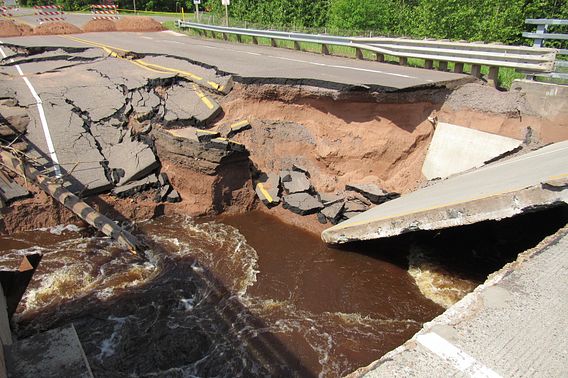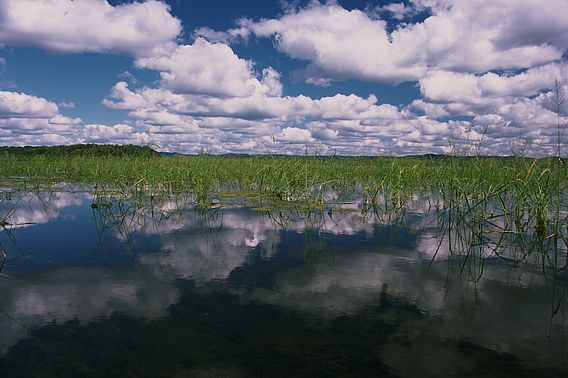Climate Change Impacts in Wisconsin
Wisconsin’s climate is changing, with far-ranging consequences for the state’s communities, world-renowned natural resources and major economic sectors.
Environmental Justice
 Communities of color, tribal nations and low-income communities are often the first and worst hit by extreme weather, industry shifts and pollution related to climate change.
Communities of color, tribal nations and low-income communities are often the first and worst hit by extreme weather, industry shifts and pollution related to climate change.All communities are impacted by global climate change. However, communities of color, tribal nations, and low-income communities are often the first and worst hit by pollution, industry shifts, extreme weather related to climate change, and other environmental health hazards. Such impacts compound those communities' existing, systemic inequities that already affect where they live and work; the quality of their air, water and food; and their economic and life opportunities. Environmental justice or climate justice refers to efforts to address these injustices.
In 2022, Wisconsin Governor Tony Evers issued Executive Order 161, directing the state Department of Administration to establish the Office of Environmental Justice. The office will, among other things, "Consult with the Office of the Governor and state agencies to develop a framework and strategy for environmental justice work across the administration."
Public Health and Safety
Climate change’s impacts on public health and safety are primary concerns for all communities. As the state has seen in recent years, more intense and frequent heavy rains due to climate change can result in flooding, eroding soil and coastlines, washing out roads and bridges, breaking dams, overwhelming sewers and wastewater treatment plants and causing greater algae blooms, bodily harm and illness. Increased frequencies of extreme heat due to climate change can cause heatstroke and exacerbate chronic illnesses, such as asthma, cardiovascular diseases and diabetes.
 Heavy rains due to climate change can result in flooding, eroding soil and coastlines, washing out roads and bridges, breaking dams and more.
Heavy rains due to climate change can result in flooding, eroding soil and coastlines, washing out roads and bridges, breaking dams and more.Habitat and survivability
Climate change impacts the habitat and survivability of many plants, wildlife and fish and is a threat to the state’s $2 billion a year fishing industry. Different fish species have different temperature requirements for feeding, growth, reproduction and survivability. Rising water temperatures in streams and lakes due to increasing air temperatures will favor warm-water species like Largemouth Bass and Bluegill over cool-water species like Walleye and Northern Pike and cold-water species like Brown Trout and Brook Trout. Wisconsin has destination fisheries for trout in the coulee streams of the Driftless Area, forested streams of the northeast, and tributaries of the Great Lakes. If summer temperatures do rise as expected, scientists project that by 2050 trout habitat in streams will decline across the state by 32% for Brown Trout and by 68% for Brook Trout.
 If summer temperatures do rise as expected, scientists predict that by 2050 trout habitat in streams will decline across the state by 32% for Brown Trout and by 68% for Brook Trout.
If summer temperatures do rise as expected, scientists predict that by 2050 trout habitat in streams will decline across the state by 32% for Brown Trout and by 68% for Brook Trout.Wild Rice
Spiritually, culturally and nutritionally important to Native Americans in Wisconsin, wild rice is an early indicator of climate change. Wild rice is vulnerable to a range of climate impacts, from warmer winters, more humid days and nights, and fluctuating lake levels to heavy rains. The plant’s range extends from Canada down into northern Wisconsin. However, climate change threatens to move the plant’s habitat farther north, putting this important resource out of reach for many tribal nations in Wisconsin.
 Wild rice is vulnerable to a range of climate impacts.
Wild rice is vulnerable to a range of climate impacts.Forest Product Industry
Wisconsin’s forest product industry will also feel the pinch. Warmer winters means more frequent thawing land, preventing machinery’s access to manage forests and transport harvested wood. However, because of the diversity of soils and forest types within the state, some tree species will be more sensitive while others will be able to adapt. For example, drier conditions and warmer temperatures will increase risk of wildfire and reduce suitable habitat for many northern and boreal tree species. Yet central Wisconsin hardwoods, like hickory, black oak and walnut are likely to adapt to warmer temperatures and expand their range across the state. Urban forests can also respond well because cities can select tree species better suited to rising temperatures. In addition, urban trees play an important cooling effect.
Agriculture
Warming temperatures and increased rainfall due to climate change brings uncertainty to Wisconsin’s agriculture sector and threaten food security. Even though warmer temperatures could benefit crop productivity by providing longer growing seasons, extreme heat conditions are stressful to crops and livestock. In addition, increasing extreme precipitation events will make it harder to plant and harvest crops, will increase soil erosion and compaction, will promote plant pests, disease and invasive species, and will lead to higher amounts of polluted runoff. This runoff could increase impacts to water quality and harm fish, plants, wildlife, livestock and people.
 Increased rainfall could lead to higher amounts of polluted runoff which could increase impacts to water quality.
Increased rainfall could lead to higher amounts of polluted runoff which could increase impacts to water quality.Tourism and Outdoor Recreation
Climate change also threatens the tourism and outdoor recreation industries, which, like forestry and agriculture, are major sectors of Wisconsin’s economy. For example, increased frequency and intensity of rain during warm months can damage and reduce access to parks, beaches, lakes, rivers and other natural resources. Those climate effects can limit camping, hiking, fishing, boating, hunting, sightseeing and other opportunities that typically draw people from around the world. Similarly, warmer winters and precipitation shifting from snow to rain or freezing rain can limit ice fishing, snowmobiling, snowshoeing and skiing opportunities, impacting local restaurants, hotels and taverns that depend on this winter recreation.
 Those climate effects can limit opportunities that typically draw people from around the world.©Travel Wisconsin
Those climate effects can limit opportunities that typically draw people from around the world.©Travel WisconsinThe impacts are many. But so are possible solutions.
